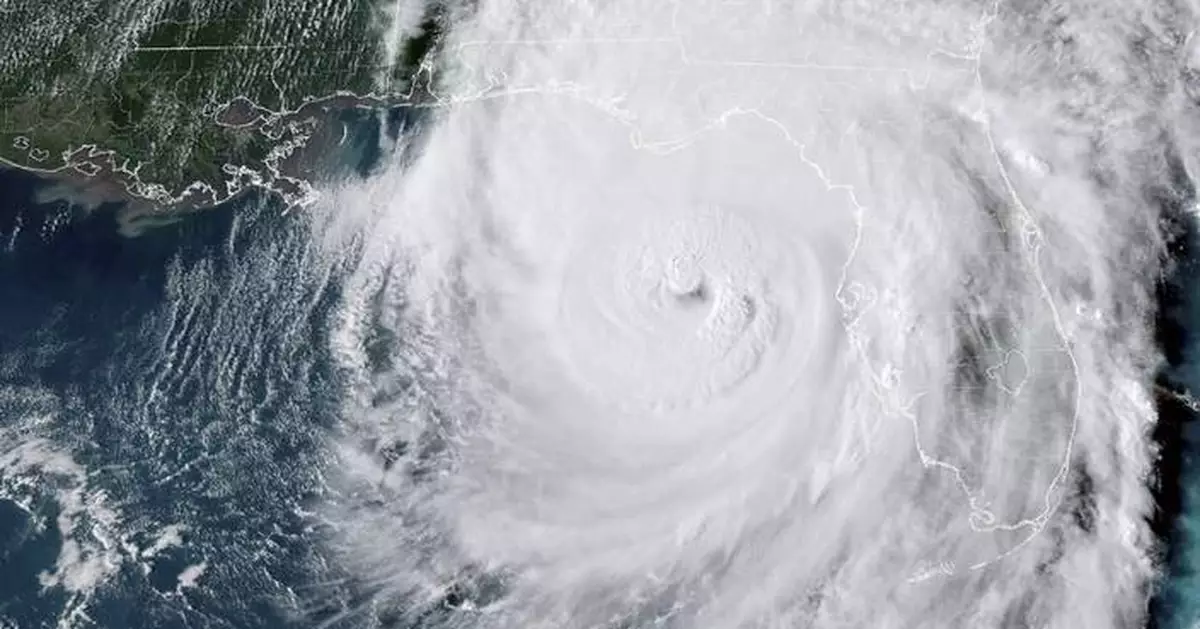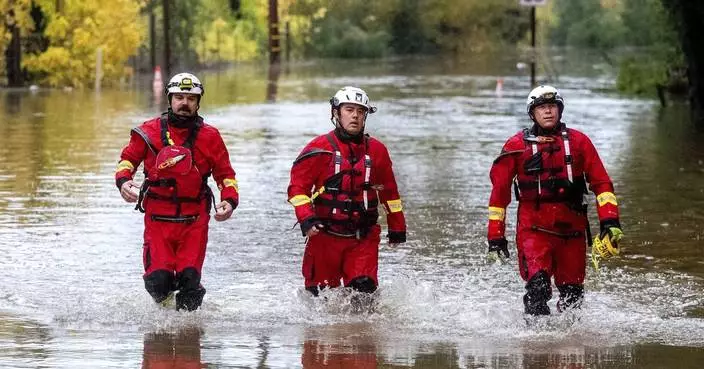FORT LAUDERDALE, Fla. (AP) — Massive Hurricane Helene crashed into Florida's sparsely populated Big Bend region, bringing storm surge and high winds across the state's Gulf Coast communities before ripping into southern Georgia. The storm has been blamed for at least 40 deaths, according to an Associated Press tally.
Hurricane Helene weakened to a tropical depression over the Carolinas with maximum sustained winds of 30 mph (48 kph) by early afternoon Friday, the National Hurricane Center said.
The storm will continue to weaken as it continues to move north. At 2 p.m., Helene was centered about 125 miles (205 kilometers) southeast of Louisville, Kentucky.
Helene wobbled as it approached Florida's coast late Thursday before making landfall near the mouth of the Aucilla River with maximum sustained winds estimated at 140 mph (225 kph). That location was only about 20 miles (32 kilometers) northwest of where Hurricane Idalia came ashore last year at nearly the same ferocity and caused widespread damage.
Evacuations were underway Friday in areas of Western North Carolina. The Haywood County Sheriff’s Office west of Asheville said it was helping with evacuations in in Cruso, Clyde, Canton and lower-lying parts of Waynesville.
Airports in Florida that closed due to Hurricane Helene were reopened Friday. That included airports in Tampa, St. Petersburg, Lakeland and Tallahassee.
At Tampa International Airport there had been 130 flight cancellations in the past 24 hours, as of Friday afternoon, according to FlightAware.
Airports in Atlanta and Charlotte, North Carolina, remained open Friday but were reporting large numbers of cancellations and heavy delays. By 2 p.m., nearly 400 flights to or from Charlotte, a major hub for American Airlines, had been canceled. Nearly 580 more, to or from Charlotte, were delayed, according to FlightAware.
At the larger Atlanta airport, 175 flights were canceled and more than 500 were delayed, according to FlightAware.
On Friday morning, inspectors were out examining bridges and causeways along Florida's Gulf Coast to get them back open to traffic quickly, Perdue said.
In addition, 2,000 miles (3,200 kilometers) of roadway across Florida have been cleared of debris, Perdue said during a news conference in Tallahassee.
“Some of the causeways were underwater, so we have to inspect them and make sure they are safe to pass,” Perdue said. “We had a lot of storm surge up and down the west coast. We had a lot of roads underwater.”
As of 2:30 p.m. Friday, some 4.2 million people across Florida, Georgia, South Carolina, North Carolina and Tennessee were without power, according to poweroutage.us.
Most of the outages were in North Carolina and South Carolina — each with more than 1 million outages. Florida had more than 840,000 customers and Georgia nearly 950,000 customers without power.
Almost 45% of homes and businesses in South Carolina were without power Friday. Whole counties were without electricity as winds gusted to near hurricane force. Trees or other debris blocked every major road leading into Greenwood, a city of about 22,000 people about 65 miles (105 kilometers) west of Columbia, Greenwood County officials said on social media.
Crews of linemen were stationed across the region, ready to begin the process of restoring power as soon as the winds from Helene died down.
Flooding along Florida's coast began well before Hurricane Helene made landfall, with rapidly rising waters reported from as far south as Fort Myers on the state's Gulf Coast.
Early Friday, sheriff's officials in Hillsborough County, where Tampa is located, were using a large ATV to rescue people who were stranded by rising waters.
In Cedar Key, an old Florida-style island off the Gulf Coast, many homes, motels and businesses were flooded. Not even the city's fire rescue building was spared.
"It actually blew out the storm panels on the front doors. Blew out one of the breakaway walls on the back and two entry doors,” the agency posted online. “It appears that we had about 6 feet or better of water inside.”
Storm surge is the level at which sea water rises above its normal level.
Much like the way a storm’s sustained winds do not include the potential for even stronger gusts, storm surge doesn’t include the wave height above the mean water level.
Surge is also the amount above what the normal tide is at a time, so a 15-foot storm surge at high tide can be far more devastating than the same surge at low tide.
The most common way to measure a hurricane’s strength is the Saffir-Simpson Scale that assigns a category from 1 to 5 based on a storm’s sustained wind speed at its center, with 5 being the strongest.

A man lights charcoal to cook dinner in his flooded home after the passage of Hurricane Helene in Guanimar, Artemisa province, Cuba, Sept. 25, 2024. (AP Photo/Ramon Espinosa)
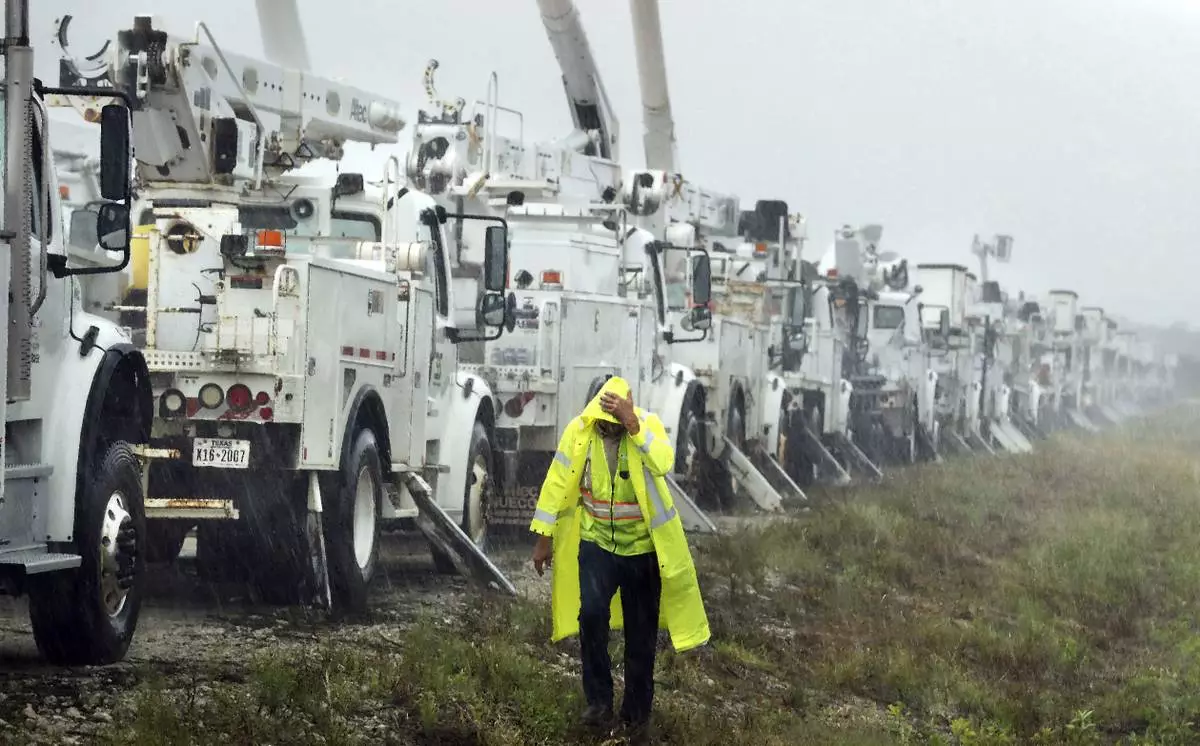
Charles Starling, a lineman with Team Fishel, is pelted with rain as he walks by a row of electrical line trucks stage in a field in The Villages, Fla., Thursday, Sept. 26, 2024, in preparation for damage from Hurricane Helene. (Stephen M. Dowell/Orlando Sentinel via AP)
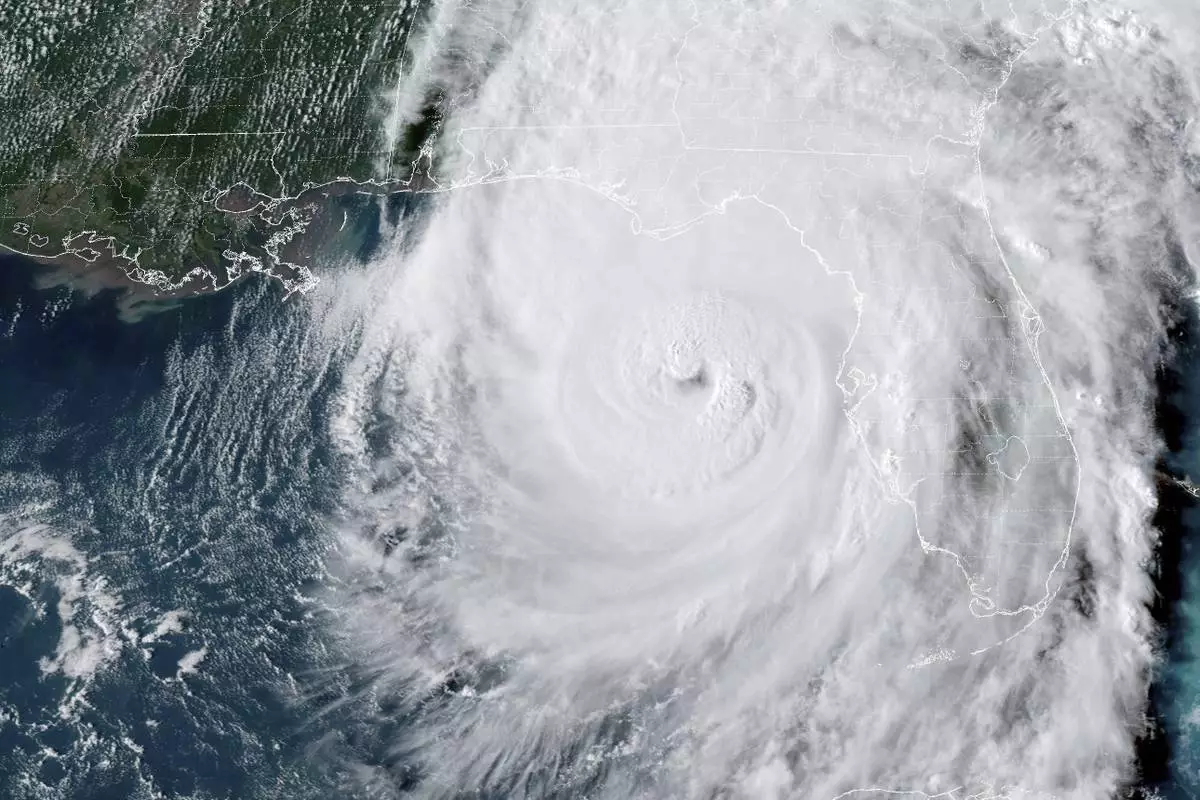
This GOES-16 GeoColor satellite image taken at 5:46 p.m. EDT and provided by National Oceanic and Atmospheric Administration (NOAA) shows Hurricane Helene in the Gulf of Mexico moving towards Florida, Thursday, Sept. 26 2024. (NOAA via AP)
BAKU, Azerbaijan (AP) — The United Nations' annual climate talks pushed into overtime Saturday under a cloud of anger and disappointment as negotiators were well short of a deal on money for developing nations to curb and adapt to climate change.
A draft of the final agreement Friday pledged $250 billion annually by 2035, more than double the previous goal of $100 billion set 15 years ago but far short of the annual $1 trillion-plus that experts say is needed. Through the early hours of Saturday morning, The Associated Press saw lead negotiators from the European Union, the United States and other nations going through the empty halls from meeting to meeting as delegates tried to hash out a new version of the deal.
“We're still working hard,” U.S. climate envoy John Podesta told the AP past 4 a.m. local time.
The climate talks, called COP29, in Baku, Azerbaijan, were scheduled to end Friday. Workers have already begun dismantling the venue for the talks.
Wealthy nations are obligated to help vulnerable countries under an agreement reached at these talks in Paris in 2015. Developing nations are seeking $1.3 trillion to help adapt to droughts, floods, rising seas and extreme heat, pay for losses and damages caused by extreme weather, and transition their energy systems away from planet-warming fossil fuels and toward clean energy.
Representatives of some of the nations that are obliged to contribute the cash said the $250 billion climate finance figure is realistic and reflects their limits at a time when their own economies are stretched.
The amount in any deal reached at COP negotiations — often considered a “core” — will then be mobilized or leveraged for greater climate spending. But much of that means loans for countries drowning in debt.
But that meant little to vulnerable nations, many already battered by extreme weather made worse largely by emissions from the burning of fossil fuels they've had little to do with. Most of those emissions have come from the developed world since the Industrial Revolution.
“Developed countries must commit trillions, not empty promises," said Harjeet Singh, Director for the Fossil Fuel Non-Proliferation Treaty Initiative. "Anything less makes them squarely responsible for the failure of these talks and the betrayal of billions across the globe.”
Nikki Reisch, director of the climate and energy program at the Center for International Environmental Law, said the offering was unacceptable not just because the money is low, but because “it’s really designed to escape and evade the legal obligation that developed countries have” to pay for the climate change they have largely caused.
Bertha Iris Argueta Tejeda, a policy advisor for a German environmental and human rights group, said the language was a “complete abdication” of the Paris agreement by developed countries.
“I thought this was a potential outcome, I just didn’t think it was going to be so blatant,” she said.
Several dozen activists marched in silence outside the halls where delegates meet late Friday, raising and crossing their arms in front of themselves to indicate rejection of the draft text.
With bleary eyes, seated around cold pizza, a group of youth activists chatted to keep each other awake in one of the main halls of the venue.
“All of us are kind of in mourning in a way,” said Jessica Dunne, with the Alliance of Non-Governmental Radical Youth. This is her fourth COP, and along with the other activists present, she’s disappointed and deeply worried about the current deal on offer. But the group said being in community eases the painful emotions that come with a process Dunne called an “abject failure.”
“In these halls tonight, as we’re sitting here and we’re talking and we’re dancing and crying and laughing, it kind of gives you hope that there will be another day that we’re going to fight for,” she said.
“I’m really tired,” said Erica Njuguna, a climate activist from Kenya. “But we are holding the line, making sure that COP delivers for people on the front lines of the climate crisis. So far it hasn’t.”
Associated Press journalist Joshua A. Bickel contributed to this report.
The Associated Press’ climate and environmental coverage receives financial support from multiple private foundations. AP is solely responsible for all content. Find AP’s standards for working with philanthropies, a list of supporters and funded coverage areas at AP.org.

John Podesta, U.S. climate envoy, center right, and U.S. Deputy Climate Envoy Sue Biniaz, center, walk outside the venue for the COP29 U.N. Climate Summit, Saturday, Nov. 23, 2024, in Baku, Azerbaijan. (AP Photo/Sergei Grits)

A member of security stands with the Baku Olympic Stadium in the background during the COP29 U.N. Climate Summit, Saturday, Nov. 23, 2024, in Baku, Azerbaijan. (AP Photo/Sergei Grits)
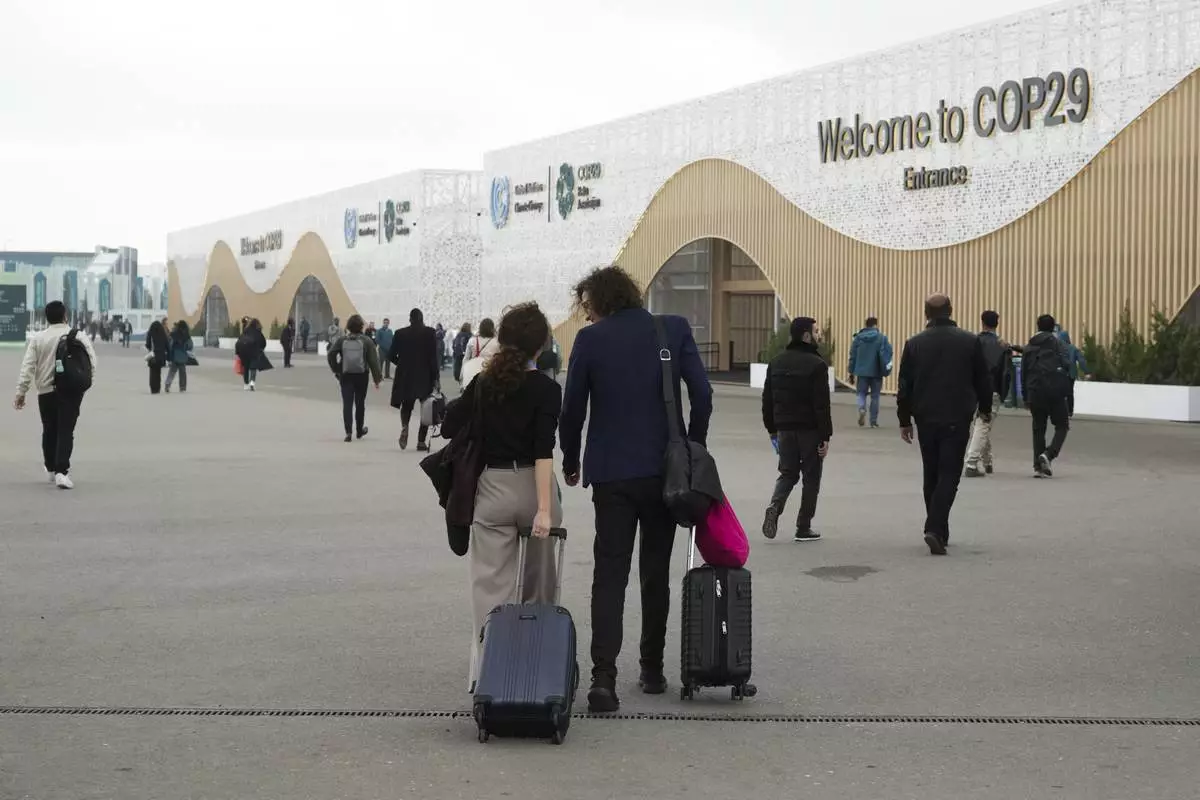
Attendees pull luggage as they walk into the venue for the COP29 U.N. Climate Summit, Saturday, Nov. 23, 2024, in Baku, Azerbaijan. (AP Photo/Sergei Grits)

Australia Climate Minister Chris Bowen, center, walks through a hallway at the COP29 U.N. Climate Summit in the early hours of Saturday, Nov. 23, 2024, in Baku, Azerbaijan. (AP Photo/Joshua A. Bickel)

U.S. Deputy Climate Envoy Sue Biniaz, right, and Wopke Hoekstra, EU climate commissioner, second from right, walk out of an elevator during the COP29 U.N. Climate Summit in the early hours of Saturday, Nov. 23, 2024, in Baku, Azerbaijan. (AP Photo/Joshua A. Bickel)

John Podesta, U.S. climate envoy, right, walks through the hallways of the COP29 U.N. Climate Summit in the early hours of Saturday, Nov. 23, 2024, in Baku, Azerbaijan. (AP Photo/Joshua A. Bickel)

People sleep in the Chinese delegation offices at the COP29 U.N. Climate Summit in the early hours of Saturday, Nov. 23, 2024, in Baku, Azerbaijan. (AP Photo/Joshua A. Bickel)

Activists demonstrate in silence protesting a draft of a proposed deal for curbing climate change at the COP29 U.N. Climate Summit, Friday, Nov. 22, 2024, in Baku, Azerbaijan. (AP Photo/Rafiq Maqbool)





